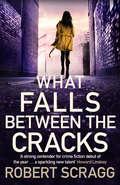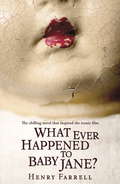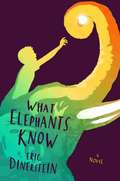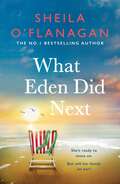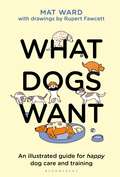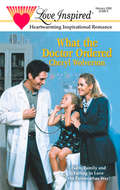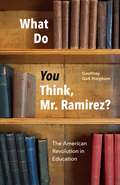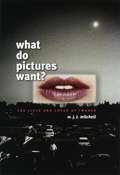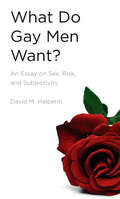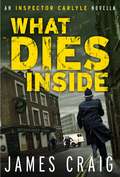- Table View
- List View
What Falls Between the Cracks: The gripping debut that will have you reading late into the night (Porter And Styles Ser. #1)
by Robert Scragg‘I RACED THROUGH THIS – ROBERT SCRAGG’S STORYTELLING IS FIRST RATE. WE’LL BE SEEING A LOT MORE OF PORTER AND STYLES’ WILLIAM RYANDID SHE SLIP, OR WAS SHE PUSHED?When a severed hand is found in an abandoned London flat, Detective Inspector Jake Porter and his partner Detective Sergeant Nick Styles are able to DNA match the limb to the owner, Natasha Barclay, who has not been seen in decades. But why has no one been looking for her?Delving into the details behind her disappearance and discovering links to another investigation, a tragic family history begins to take on a darker twist. Natasha’s nearest and dearest are the people who can least be trusted.Hampered by a widespread fear of a local heavy, as well as internal politics and possible corruption within the force, Porter and Styles are digging for answers, but will what they find ever see the light of day?‘I LOVED IT. I READ IT IN TWO DAYS ... A REAL, CLASSIC WHODUNNIT’ NIKI MACKAY‘A strong contender for crime fiction debut of the year … a sparkling new talent’ Howard Linksey
What Falls Apart (Oberon Modern Plays)
by Torben BettsMay 2015: The most important General Election for a generation. All is not well for Tom Savage, an ex-Labour minister parachuted into a safe North East constituency, trying to win hearts and minds as well as an Election. Wrestling with a heady cocktail of mid-life crisis, growing dependency on alcohol and the consequences of his Government’s policies in Iraq, Tom finds himself in a Tyneside hotel bar at midnight with a newly teetotal barman and a ‘criminally attractive’ woman. What could possibly go wrong? Plenty…
What Every Novelist Needs to Know about Narrators (Chicago Shorts)
by Wayne C. BoothWayne Booth transformed the study of fiction in the twentieth century and wrote some of the most influential and engaging criticism of our time. In What Every Novelist Needs to Know about Narrators, Booth tackles one of the most difficult issues writers of fiction face: the choice of which narrative approach to take in their work. With trademark Booth aplomb, he articulates the methods behind dramatization, character development, and point of view that are indispensable for successful writing. How far the narrator sees, how she or he thinks, and how those thoughts connect with—or diverge from—those of the reader, writer, or other characters in the story: these are tools that are key to narration, and here Booth considers them in this worthy selection.
What Ever Happened to Baby Jane?
by Henry FarrellThe literary classic that inspired the iconic film - the story of two sisters and the hell they made their home.Once an acclaimed child star of vaudeville, Baby Jane Hudson performed for adoring crowds before a move to Hollywood thrust her sister, Blanche, into the spotlight. As Blanche's film career took off, a resentful Jane watched from the shadows as her own career faded into obscurity - until a tragic accident changed everything. Now, years later, the two sisters live in a decaying mansion, isolated from the outside world. Crippled by the accident, Blanche is helpless under the control of her abusive sister, who is slowly descending into madness. And when Baby Jane decides it's time to revive her childhood act, she won't let anything - or anyone - stand in her way. This edition features exclusive extra material: three previously unpublished short stories by Henry Farrell, including the inspiration for the movie Hush...Hush, Sweet Charlotte, and an introduction that reveals how the original novel came about as well as the behind-the-scenes drama of the iconic film starring Joan Crawford and Bette Davis, now recreated in the TV show Feud.
What Else Is Pastoral?: Renaissance Literature and the Environment
by Ken HiltnerPastoral was one of the most popular literary forms of early modern England. Inspired by classical and Italian Renaissance antecedents, writers from Ben Jonson to John Beaumont and Abraham Cowley wrote in idealized terms about the English countryside. It is often argued that the Renaissance pastoral was a highly figurative mode of writing that had more to do with culture and politics than with the actual countryside of England. For decades now literary criticism has had it that in pastoral verse, hills and crags and moors were extolled for their metaphoric worth, rather than for their own qualities. In What Else Is Pastoral? Ken Hiltner takes a fresh look at pastoral, offering an environmentally minded reading that reconnects the poems with literal landscapes, not just figurative ones.Considering the pastoral in literature from Virgil and Petrarch to Jonson and Milton, Hiltner proposes a new ecocritical approach to these texts. We only become truly aware of our environment, he explains, when its survival is threatened. As London expanded rapidly during the sixteenth and seventeenth centuries, the city and surrounding rural landscapes began to look markedly different. Hiltner finds that Renaissance writers were acutely aware that the countryside they had known was being lost to air pollution, deforestation, and changing patterns of land use; their works suggest this new absence of nature through their appreciation for the scraps that remained in memory or in fact. A much-needed corrective to the prevailing interpretation of pastoral poetry, What Else Is Pastoral? shows the value of reading literature with an ecological eye.
What Elephants Know
by Eric DinersteinAbandoned in the jungle of the Nepalese Borderlands, two-year-old Nandu is found living under the protective watch of a pack of wild dogs. From his mysterious beginnings, fate delivers him to the King's elephant stable, where he is raised by unlikely parents-the wise head of the stable, Subba-sahib, and Devi Kali, a fierce and affectionate female elephant. When the king's government threatens to close the stable, Nandu, now twelve, searches for a way to save his family and community. A risky plan could be the answer. But to succeed, they'll need a great tusker. The future is in Nandu's hands as he sets out to find a bull elephant and bring him back to the Borderlands. In simple poetic prose, author Eric Dinerstein brings to life Nepal's breathtaking jungle wildlife and rural culture, as seen through the eyes of a young outcast, struggling to find his place in the world.
What Eden Did Next: The moving and uplifting bestseller you'll never forget
by Sheila O'FlanaganTHE NO. 1 BESTSELLERShe's ready to move on. But will her family let her?'One of my favourite authors' Marian KeyesAn unforgettable marriageFive years ago, the bottom fell out of Eden's world when her firefighter husband died. Now, instead of the future she had planned with Andy, she has Lila - the daughter he never got the chance to meet. Instead of Andy, she has his family.An unexpected romanceThen an old friend comes back into Eden's life: someone who doesn't see her as a widow or a mother; someone who reminds her of how she used to be. Suddenly she's having fun again. But Andy's mother has other plans for Eden, who soon faces an impossible decision. One that could tear a family apart . . .An impossible choiceCompassionate, irresistible and honest, What Eden Did Next is a sometimes heart-breaking, ultimately joyful, novel of love, loss - and finding your own way to happiness.What readers are saying about What Eden Did Next 'Absolutely loved this book' ⭐ ⭐ ⭐ ⭐ ⭐'A story that grips you . . . you can't wait to see what happens next' ⭐ ⭐ ⭐ ⭐ ⭐'Definitely a five star read' ⭐ ⭐ ⭐ ⭐ ⭐'A truly wonderful book' ⭐ ⭐ ⭐ ⭐ ⭐Praise for Sheila O'Flanagan'Reading a Sheila O'Flanagan novel always feels like sitting down for a cup of tea with a friend - she writes with such warmth and empathy' Beth O'Leary'A novel which celebrates strong women who can carve out their own happy endings' Linda Green'Sheila writes with such verve and positivity and emotional intelligence - she knows just what it is to be a woman' Veronica Henry'A refreshing, unapologetic, funny, absorbing page-turner which left me wanting to read another Sheila O'Flanagan novel straight away!' Emily Gunnis
What A Duke Dares: Silk Is For Seduction / Scandal Wears Satin / Vixen In Velvet / Seven Nights In A Rogue's Bed / A Rake's Midnight Kiss / What A Duke Dares (Mills And Boon M&b Ser. #3)
by Anna Campbell‘I can’t kidnap her!’ ‘If you have to, you must. Bring Pen home.’
What Dogs Want: An illustrated guide for HAPPY dog care and training
by Mat WardHow to have fun AND be a fantastic dog owner! Mat Ward is a leading behaviourist and he really can understand what our dogs are thinking. His advice comes with funny but accurate pictures explaining everything you need to know – including what different woofs might mean, how to read a dog's ears and why they wag their tails (it's not always what you think). Our pets may seem straightforward but learning some key training basics and thinking about little details (like what kind of collar to put on them) can make all the difference. Understanding and respect mean your dog lives a contented life – and if the dog feels happy, then so will you!
What Does Consent Really Mean? (PDF)
by Pete Wallis Joseph Wilkins Thalia Wallis"Consent is not the absence of 'NO', it is an enthusiastic YES!!" While seemingly straightforward, Tia and Bryony hadn't considered this subject too seriously until it comes up in conversation with their friends and they realise just how important it is. Following the sexual assault of a classmate, a group of teenage girls find themselves discussing the term consent, what it actually means for them in their current relationships, and how they act and make decisions with peer influence. Joined by their male friends who offer another perspective, this rich graphic novel uncovers the need for more informed conversations with young people around consent and healthy relationships. Accompanying the graphics are sexual health resources for students and teachers, which make this a perfect tool for broaching the subject with teens.
What The Doctor Ordered (Fairweather #1)
by Cheryl WolvertonCome and meet the folks of Fairweather, Minnesota, the small town with the big heart that you'll want to return to again and again!
What Do You Think, Mr. Ramirez?: The American Revolution in Education
by Geoffrey Galt HarphamGeoffrey Galt Harpham’s book takes its title from a telling anecdote. A few years ago Harpham met a Cuban immigrant on a college campus, who told of arriving, penniless and undocumented, in the 1960s and eventually earning a GED and making his way to a community college. In a literature course one day, the professor asked him, “Mr. Ramirez, what do you think?” The question, said Ramirez, changed his life because “it was the first time anyone had asked me that.” Realizing that his opinion had value set him on a course that led to his becoming a distinguished professor. That, says Harpham, was the midcentury promise of American education, the deep current of commitment and aspiration that undergirded the educational system that was built in the postwar years, and is under extended assault today. The United States was founded, he argues, on the idea that interpreting its foundational documents was the highest calling of opinion, and for a brief moment at midcentury, the country turned to English teachers as the people best positioned to train students to thrive as interpreters—which is to say as citizens of a democracy. Tracing the roots of that belief in the humanities through American history, Harpham builds a strong case that, even in very different contemporary circumstances, the emphasis on social and cultural knowledge that animated the midcentury university is a resource that we can, and should, draw on today.
What Do You Think, Mr. Ramirez?: The American Revolution in Education
by Geoffrey Galt HarphamGeoffrey Galt Harpham’s book takes its title from a telling anecdote. A few years ago Harpham met a Cuban immigrant on a college campus, who told of arriving, penniless and undocumented, in the 1960s and eventually earning a GED and making his way to a community college. In a literature course one day, the professor asked him, “Mr. Ramirez, what do you think?” The question, said Ramirez, changed his life because “it was the first time anyone had asked me that.” Realizing that his opinion had value set him on a course that led to his becoming a distinguished professor. That, says Harpham, was the midcentury promise of American education, the deep current of commitment and aspiration that undergirded the educational system that was built in the postwar years, and is under extended assault today. The United States was founded, he argues, on the idea that interpreting its foundational documents was the highest calling of opinion, and for a brief moment at midcentury, the country turned to English teachers as the people best positioned to train students to thrive as interpreters—which is to say as citizens of a democracy. Tracing the roots of that belief in the humanities through American history, Harpham builds a strong case that, even in very different contemporary circumstances, the emphasis on social and cultural knowledge that animated the midcentury university is a resource that we can, and should, draw on today.
What Do You Think, Mr. Ramirez?: The American Revolution in Education
by Geoffrey Galt HarphamGeoffrey Galt Harpham’s book takes its title from a telling anecdote. A few years ago Harpham met a Cuban immigrant on a college campus, who told of arriving, penniless and undocumented, in the 1960s and eventually earning a GED and making his way to a community college. In a literature course one day, the professor asked him, “Mr. Ramirez, what do you think?” The question, said Ramirez, changed his life because “it was the first time anyone had asked me that.” Realizing that his opinion had value set him on a course that led to his becoming a distinguished professor. That, says Harpham, was the midcentury promise of American education, the deep current of commitment and aspiration that undergirded the educational system that was built in the postwar years, and is under extended assault today. The United States was founded, he argues, on the idea that interpreting its foundational documents was the highest calling of opinion, and for a brief moment at midcentury, the country turned to English teachers as the people best positioned to train students to thrive as interpreters—which is to say as citizens of a democracy. Tracing the roots of that belief in the humanities through American history, Harpham builds a strong case that, even in very different contemporary circumstances, the emphasis on social and cultural knowledge that animated the midcentury university is a resource that we can, and should, draw on today.
What Do You Think, Mr. Ramirez?: The American Revolution in Education
by Geoffrey Galt HarphamGeoffrey Galt Harpham’s book takes its title from a telling anecdote. A few years ago Harpham met a Cuban immigrant on a college campus, who told of arriving, penniless and undocumented, in the 1960s and eventually earning a GED and making his way to a community college. In a literature course one day, the professor asked him, “Mr. Ramirez, what do you think?” The question, said Ramirez, changed his life because “it was the first time anyone had asked me that.” Realizing that his opinion had value set him on a course that led to his becoming a distinguished professor. That, says Harpham, was the midcentury promise of American education, the deep current of commitment and aspiration that undergirded the educational system that was built in the postwar years, and is under extended assault today. The United States was founded, he argues, on the idea that interpreting its foundational documents was the highest calling of opinion, and for a brief moment at midcentury, the country turned to English teachers as the people best positioned to train students to thrive as interpreters—which is to say as citizens of a democracy. Tracing the roots of that belief in the humanities through American history, Harpham builds a strong case that, even in very different contemporary circumstances, the emphasis on social and cultural knowledge that animated the midcentury university is a resource that we can, and should, draw on today.
What Do You Think, Mr. Ramirez?: The American Revolution in Education
by Geoffrey Galt HarphamGeoffrey Galt Harpham’s book takes its title from a telling anecdote. A few years ago Harpham met a Cuban immigrant on a college campus, who told of arriving, penniless and undocumented, in the 1960s and eventually earning a GED and making his way to a community college. In a literature course one day, the professor asked him, “Mr. Ramirez, what do you think?” The question, said Ramirez, changed his life because “it was the first time anyone had asked me that.” Realizing that his opinion had value set him on a course that led to his becoming a distinguished professor. That, says Harpham, was the midcentury promise of American education, the deep current of commitment and aspiration that undergirded the educational system that was built in the postwar years, and is under extended assault today. The United States was founded, he argues, on the idea that interpreting its foundational documents was the highest calling of opinion, and for a brief moment at midcentury, the country turned to English teachers as the people best positioned to train students to thrive as interpreters—which is to say as citizens of a democracy. Tracing the roots of that belief in the humanities through American history, Harpham builds a strong case that, even in very different contemporary circumstances, the emphasis on social and cultural knowledge that animated the midcentury university is a resource that we can, and should, draw on today.
What Do You Think, Mr. Ramirez?: The American Revolution in Education
by Geoffrey Galt HarphamGeoffrey Galt Harpham’s book takes its title from a telling anecdote. A few years ago Harpham met a Cuban immigrant on a college campus, who told of arriving, penniless and undocumented, in the 1960s and eventually earning a GED and making his way to a community college. In a literature course one day, the professor asked him, “Mr. Ramirez, what do you think?” The question, said Ramirez, changed his life because “it was the first time anyone had asked me that.” Realizing that his opinion had value set him on a course that led to his becoming a distinguished professor. That, says Harpham, was the midcentury promise of American education, the deep current of commitment and aspiration that undergirded the educational system that was built in the postwar years, and is under extended assault today. The United States was founded, he argues, on the idea that interpreting its foundational documents was the highest calling of opinion, and for a brief moment at midcentury, the country turned to English teachers as the people best positioned to train students to thrive as interpreters—which is to say as citizens of a democracy. Tracing the roots of that belief in the humanities through American history, Harpham builds a strong case that, even in very different contemporary circumstances, the emphasis on social and cultural knowledge that animated the midcentury university is a resource that we can, and should, draw on today.
What Do Pictures Want?: The Lives and Loves of Images
by W. J. MitchellWhy do we have such extraordinarily powerful responses toward the images and pictures we see in everyday life? Why do we behave as if pictures were alive, possessing the power to influence us, to demand things from us, to persuade us, seduce us, or even lead us astray? According to W. J. T. Mitchell, we need to reckon with images not just as inert objects that convey meaning but as animated beings with desires, needs, appetites, demands, and drives of their own. What Do Pictures Want? explores this idea and highlights Mitchell's innovative and profoundly influential thinking on picture theory and the lives and loves of images. Ranging across the visual arts, literature, and mass media, Mitchell applies characteristically brilliant and wry analyses to Byzantine icons and cyberpunk films, racial stereotypes and public monuments, ancient idols and modern clones, offensive images and found objects, American photography and aboriginal painting. Opening new vistas in iconology and the emergent field of visual culture, he also considers the importance of Dolly the Sheep—who, as a clone, fulfills the ancient dream of creating a living image—and the destruction of the World Trade Center on 9/11, which, among other things, signifies a new and virulent form of iconoclasm. What Do Pictures Want? offers an immensely rich and suggestive account of the interplay between the visible and the readable. A work by one of our leading theorists of visual representation, it will be a touchstone for art historians, literary critics, anthropologists, and philosophers alike. “A treasury of episodes—generally overlooked by art history and visual studies—that turn on images that ‘walk by themselves’ and exert their own power over the living.”—Norman Bryson, Artforum
What Do Pictures Want?: The Lives and Loves of Images (Prehistoric Archeology And Ecology Ser.)
by W. J. MitchellWhy do we have such extraordinarily powerful responses toward the images and pictures we see in everyday life? Why do we behave as if pictures were alive, possessing the power to influence us, to demand things from us, to persuade us, seduce us, or even lead us astray? According to W. J. T. Mitchell, we need to reckon with images not just as inert objects that convey meaning but as animated beings with desires, needs, appetites, demands, and drives of their own. What Do Pictures Want? explores this idea and highlights Mitchell's innovative and profoundly influential thinking on picture theory and the lives and loves of images. Ranging across the visual arts, literature, and mass media, Mitchell applies characteristically brilliant and wry analyses to Byzantine icons and cyberpunk films, racial stereotypes and public monuments, ancient idols and modern clones, offensive images and found objects, American photography and aboriginal painting. Opening new vistas in iconology and the emergent field of visual culture, he also considers the importance of Dolly the Sheep—who, as a clone, fulfills the ancient dream of creating a living image—and the destruction of the World Trade Center on 9/11, which, among other things, signifies a new and virulent form of iconoclasm. What Do Pictures Want? offers an immensely rich and suggestive account of the interplay between the visible and the readable. A work by one of our leading theorists of visual representation, it will be a touchstone for art historians, literary critics, anthropologists, and philosophers alike. “A treasury of episodes—generally overlooked by art history and visual studies—that turn on images that ‘walk by themselves’ and exert their own power over the living.”—Norman Bryson, Artforum
What Do Pictures Want?: The Lives and Loves of Images
by W. J. MitchellWhy do we have such extraordinarily powerful responses toward the images and pictures we see in everyday life? Why do we behave as if pictures were alive, possessing the power to influence us, to demand things from us, to persuade us, seduce us, or even lead us astray? According to W. J. T. Mitchell, we need to reckon with images not just as inert objects that convey meaning but as animated beings with desires, needs, appetites, demands, and drives of their own. What Do Pictures Want? explores this idea and highlights Mitchell's innovative and profoundly influential thinking on picture theory and the lives and loves of images. Ranging across the visual arts, literature, and mass media, Mitchell applies characteristically brilliant and wry analyses to Byzantine icons and cyberpunk films, racial stereotypes and public monuments, ancient idols and modern clones, offensive images and found objects, American photography and aboriginal painting. Opening new vistas in iconology and the emergent field of visual culture, he also considers the importance of Dolly the Sheep—who, as a clone, fulfills the ancient dream of creating a living image—and the destruction of the World Trade Center on 9/11, which, among other things, signifies a new and virulent form of iconoclasm. What Do Pictures Want? offers an immensely rich and suggestive account of the interplay between the visible and the readable. A work by one of our leading theorists of visual representation, it will be a touchstone for art historians, literary critics, anthropologists, and philosophers alike. “A treasury of episodes—generally overlooked by art history and visual studies—that turn on images that ‘walk by themselves’ and exert their own power over the living.”—Norman Bryson, Artforum
What Do Pictures Want?: The Lives and Loves of Images
by W. J. MitchellWhy do we have such extraordinarily powerful responses toward the images and pictures we see in everyday life? Why do we behave as if pictures were alive, possessing the power to influence us, to demand things from us, to persuade us, seduce us, or even lead us astray? According to W. J. T. Mitchell, we need to reckon with images not just as inert objects that convey meaning but as animated beings with desires, needs, appetites, demands, and drives of their own. What Do Pictures Want? explores this idea and highlights Mitchell's innovative and profoundly influential thinking on picture theory and the lives and loves of images. Ranging across the visual arts, literature, and mass media, Mitchell applies characteristically brilliant and wry analyses to Byzantine icons and cyberpunk films, racial stereotypes and public monuments, ancient idols and modern clones, offensive images and found objects, American photography and aboriginal painting. Opening new vistas in iconology and the emergent field of visual culture, he also considers the importance of Dolly the Sheep—who, as a clone, fulfills the ancient dream of creating a living image—and the destruction of the World Trade Center on 9/11, which, among other things, signifies a new and virulent form of iconoclasm. What Do Pictures Want? offers an immensely rich and suggestive account of the interplay between the visible and the readable. A work by one of our leading theorists of visual representation, it will be a touchstone for art historians, literary critics, anthropologists, and philosophers alike. “A treasury of episodes—generally overlooked by art history and visual studies—that turn on images that ‘walk by themselves’ and exert their own power over the living.”—Norman Bryson, Artforum
What Do Pictures Want?: The Lives and Loves of Images (Prehistoric Archeology And Ecology Ser.)
by W. J. MitchellWhy do we have such extraordinarily powerful responses toward the images and pictures we see in everyday life? Why do we behave as if pictures were alive, possessing the power to influence us, to demand things from us, to persuade us, seduce us, or even lead us astray? According to W. J. T. Mitchell, we need to reckon with images not just as inert objects that convey meaning but as animated beings with desires, needs, appetites, demands, and drives of their own. What Do Pictures Want? explores this idea and highlights Mitchell's innovative and profoundly influential thinking on picture theory and the lives and loves of images. Ranging across the visual arts, literature, and mass media, Mitchell applies characteristically brilliant and wry analyses to Byzantine icons and cyberpunk films, racial stereotypes and public monuments, ancient idols and modern clones, offensive images and found objects, American photography and aboriginal painting. Opening new vistas in iconology and the emergent field of visual culture, he also considers the importance of Dolly the Sheep—who, as a clone, fulfills the ancient dream of creating a living image—and the destruction of the World Trade Center on 9/11, which, among other things, signifies a new and virulent form of iconoclasm. What Do Pictures Want? offers an immensely rich and suggestive account of the interplay between the visible and the readable. A work by one of our leading theorists of visual representation, it will be a touchstone for art historians, literary critics, anthropologists, and philosophers alike. “A treasury of episodes—generally overlooked by art history and visual studies—that turn on images that ‘walk by themselves’ and exert their own power over the living.”—Norman Bryson, Artforum
What Do Pictures Want?: The Lives and Loves of Images
by W. J. MitchellWhy do we have such extraordinarily powerful responses toward the images and pictures we see in everyday life? Why do we behave as if pictures were alive, possessing the power to influence us, to demand things from us, to persuade us, seduce us, or even lead us astray? According to W. J. T. Mitchell, we need to reckon with images not just as inert objects that convey meaning but as animated beings with desires, needs, appetites, demands, and drives of their own. What Do Pictures Want? explores this idea and highlights Mitchell's innovative and profoundly influential thinking on picture theory and the lives and loves of images. Ranging across the visual arts, literature, and mass media, Mitchell applies characteristically brilliant and wry analyses to Byzantine icons and cyberpunk films, racial stereotypes and public monuments, ancient idols and modern clones, offensive images and found objects, American photography and aboriginal painting. Opening new vistas in iconology and the emergent field of visual culture, he also considers the importance of Dolly the Sheep—who, as a clone, fulfills the ancient dream of creating a living image—and the destruction of the World Trade Center on 9/11, which, among other things, signifies a new and virulent form of iconoclasm. What Do Pictures Want? offers an immensely rich and suggestive account of the interplay between the visible and the readable. A work by one of our leading theorists of visual representation, it will be a touchstone for art historians, literary critics, anthropologists, and philosophers alike. “A treasury of episodes—generally overlooked by art history and visual studies—that turn on images that ‘walk by themselves’ and exert their own power over the living.”—Norman Bryson, Artforum
What Do Gay Men Want?: An Essay on Sex, Risk, and Subjectivity
by David Halperin“Compelling, timely, and provocative. The writing is sleek and exhilarating. It doesn’t waste time telling us what it will do or what it has just done—it just does it.” —Don Kulick, Professor of Anthropology, New York University How we can talk about sex and risk in the age of barebacking—or condomless sex—without invoking the usual bogus and punitive clichés about gay men’s alleged low self-esteem, lack of self-control, and other psychological “deficits”? Are there queer alternatives to psychology for thinking about the inner life of homosexuality? What Do Gay Men Want? explores some of the possibilities. Unlike most writers on the topic of gay men and risky sex, David Halperin liberates gay male subjectivity from psychology, demonstrating the insidious ways in which psychology’s defining opposition between the normal and the pathological subjects homosexuality to medical reasoning and revives a whole set of unexamined moral assumptions about “good” sex and “bad” sex. In particular, Halperin champions neglected traditions of queer thought, including both literary and popular discourses, by drawing on the work of well-known figures like Jean Genet and neglected ones like Marcel Jouhandeau. He shows how the long history of of gay men’s uses of “abjection” can offer an alternative, nonmoralistic model for thinking about gay male subjectivity, something which is urgently needed in the age of barebacking. Anyone searching for nondisciplinary ways to slow the spread of HIV/AIDS among gay men—or interested in new modes of thinking about gay male subjectivity—should read this book. David M. Halperin is W. H. Auden Collegiate Professor of the History and Theory of Sexuality, Professor of English, Professor of Women’s Studies, Professor of Comparative Literature, and Adjunct Professor of Classical Studies at the University of Michigan.
What Dies Inside: An Inspector Carlyle Novella
by James CraigLondon, October 1984: Irish terrorists have blown up British Prime Minister Margaret Thatcher in a hotel near London. Gerry Durkan, the prime suspect, is on the run in west London and Constable John Carlyle is drafted in to join the hunt to find him.The increasingly frantic search exposes rivalries in the security services as up and coming MI5 agent Martin Palmer goes up against Special Branch veteran Mark Cahill. Palmer needs to find Durkan first, or see his embryonic career go into reverse. But the young spook has a dirty secret of his own, one that he will kill to keep.
